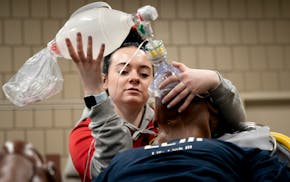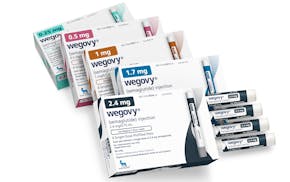A blood pressure check may be one of the most tried and true routines of a visit to the doctor's office. But a group of Allina Health doctors in Edina is challenging the reliability of the conventional test and is trying a new method they believe could provide a more accurate diagnosis for thousands of patients who suffer from hypertension.
While few doubt that routine checks help millions of Americans control their high blood pressure, there is growing evidence that these point-in-time readings overdiagnose some patients — people whose numbers go up at the doctors' office simply because of nerves — while underdiagnosing others whose hidden hypertension puts them at greater risk for stroke and heart disease.
"The reality is [that] your blood pressure fluctuates day to day, hour to hour, minute to minute," said Dr. David Ingham, who practices at Allina's Center for Outpatient Care in Edina. "And those fluctuations are important."
Over the past year, Ingham and his colleagues have been testing a new device on more than 1,000 Twin Cities patients to see whether 24-hour blood pressure monitoring can provide a more accurate diagnosis.
One of those patients is 37-year-old Jeff Zoss of Minnetonka, who agreed to wear the wireless monitor. It was strapped to his left arm and took his blood pressure every 20 minutes, then tracked his scores so they could be uploaded to the doctors.
It was an uncomfortable day. Zoss tried hiding the wallet-sized device under a puffy shirt, but co-workers at the office noticed when it inflated. And it kept waking him at night. But in the end, the new device found that an earlier diagnosis of high blood pressure was inaccurate, allowing him to stop taking medication.
"It's not like you'd wear it for fun," Zoss said. "But to find out you can eliminate any sort of medication that you'll otherwise be taking for life? … It's nothing."
76 million Americans
The technology for 24-hour monitoring has existed for 20 years, but received little interest until Britain's National Health Service opted two years ago to offer it to patients suspected of having high blood pressure. British authorities reasoned that they would save money overall, because the 24-hour tests would spare the expense of blood pressure medication for people whose prescriptions were based on faulty office screenings.
Better readings could make a huge difference in the United States: More than 76 million American adults have hypertension — a leading cause of stroke as well as heart and kidney problems — but a majority either don't know they have it or aren't being treated for it.
The Allina study comes at a key time, because influential medical groups are reviewing U.S. guidelines on the screening and management of high blood pressure. The U.S. Preventive Services Task Force, the nation's leading authority on medical screenings such as mammograms, is reviewing its recommendations on blood pressure and is reconsidering the role of 24-hour monitoring.
The U.S. Centers for Disease Control and Prevention (CDC), meanwhile, is offering rewards to clinics that effectively manage patients' blood pressure.
Just last week, CDC director Dr. Tom Frieden spent two days in the Twin Cities to learn the secrets of local clinics that blow away national averages when it comes to the share of patients with healthy scores.
"Blood pressure wins hands down in terms of the most important things to do right in health care," Frieden said during a visit Thursday with the Star Tribune editorial board.
Frieden expressed skepticism about the need for 24-hour monitoring, given the strides some clinics make just by a firm commitment to more standard measurements. His visit was prompted by a 2012 study showing that Minnesota clinics accomplished a fourfold decline in patients with uncontrolled blood pressure by using frequent office checks and aggressively prescribing medications such as diuretics or ACE inhibitors.
"What we know is helpful," Frieden said, "is for people to know what their blood pressure is."
Trouble is, some people think they know their blood pressure, but don't, said Dr. Michael Cummings, the Allina doctor leading the research on 24-hour testing.
Studies have found that as many as 20 percent of people with high blood pressure in office screenings have "white coat" hypertension — which means they have elevated blood pressure only at the doctor's office. Cummings said 24-hour checks of patients at his clinic have found almost 30 percent have "white coat" hypertension and don't necessarily need medication.
Similarly, office blood pressure tests miss as many as 10 to 15 percent of patients with "masked" hypertension that does require treatment.
False negative
Zoss appears to have been a "white coat" case, although he has a family history of hypertension and one day could have the real thing.
Jerry Lutgen, of St. Paul, ended up with a different result. After monitoring his calories and running and swimming more, the 66-year-old reduced his blood pressure to the point that a standard office reading had him at healthy levels. Then he agreed to a 24-hour test — and found that he still had high blood pressure and would need to continue medication.
"I thought I had cleaned up my act enough that I was going to be free from blood pressure medication," Lutgen said, "but the good news is that I've reduced it."
He said he wonders whether more regular home monitoring would be as effective as the 24-hour test, because he, too, said the device was a nuisance when he was sleeping.
But periodic home monitoring doesn't track blood pressure when people sleep, Cummings said, whereas 24-hour monitoring provides vital overnight data. Typically, blood pressure dips when people sleep. But for a small share of people with hypertension, blood pressure stays cranked up overnight. Cummings said studies have found that these people might be at the highest risk of complications from hypertension.
Cummings wants to make an economic case for 24-hour testing, also called "ambulatory" blood pressure monitoring, in primary care clinics. In the time that the telephone has evolved from a wooden box to a hand-held supercomputer, Cummings said, there has been little change in the standard blood pressure cuff, which was invented in the late 1800s.
Doctors, however, are unlikely to use the new devices unless insurers expand coverage. The federal Medicare program for seniors mostly covers 24-hour studies to confirm "white coat" hypertension — a paradox in that patients don't know they have "white coat" cases until after the studies. Other insurers only cover the tests to confirm office readings or if recommended by cardiologists.
Increased use of the devices in primary care will be more likely if the U.S. Preventive Services Task Force recommends 24-hour monitoring in some way. The task force is two to three years from updating its guidelines on blood pressure screening, but it is expected to review ambulatory screening, said Dr. Karen Margolis, a researcher for Bloomington-based HealthPartners who is on the task force's blood pressure screening committee.
Margolis said 24-hour testing is considered the "gold standard" for measuring blood pressure: "It may be the best approximation of truth that we have without sticking a catheter in somebody's arteries."
But when the 24-hour tests are worth the additional cost and when they are overkill is unclear. It's also unclear how they could identify more "masked" hypertension cases unless they were given to all patients, regardless of blood pressure.
"It's a big commitment," Margolis said. "Some people find it very disruptive having this thing blowing up on your arm as you sleep."
Jeremy Olson • 612-673-7744

Hospitals too busy to train Minnesota paramedic students, exacerbating shortage

Minnesota pharmacies want permission, funding to administer vaccines

Showdown set between Minnesota and drug industry over rising costs

Doctors, nurses speak out against closure of intensive care unit at Unity hospital campus
